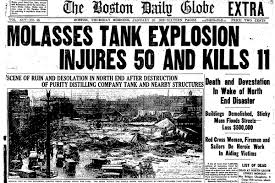The Great Molasses Flood was set in motion by a massive storage tank, built by the Purity Distilling Company, which held molasses used for the production of rum and other products. The tank was poorly constructed and not adequately maintained, leading to concerns about its structural integrity. On the day of the disaster, warm weather caused the molasses to expand, increasing pressure on the tank's already weakened walls.
At 12:30 PM, the tank burst, unleashing a torrent of molasses that swept through the streets of the North End neighborhood. The wave, estimated to be 25 feet high in some areas, destroyed buildings, overturned vehicles, and caught pedestrians and horses off guard. The thick molasses trapped victims, making rescue efforts incredibly difficult.
Emergency services struggled to respond due to the viscous nature of the molasses, and many first responders found themselves stuck. The cleanup took weeks, with local residents reportedly using saltwater and sand to help absorb the sticky substance. In the aftermath, lawsuits ensued, and the event prompted investigations into the safety regulations surrounding industrial facilities.
Ultimately, the Great Molasses Flood became a cautionary tale about industrial oversight, leading to stricter building codes and safety measures in the United States. Today, the disaster is remembered not only for its tragic loss of life but also for its unusual nature, earning its place in the annals of bizarre historical events.


